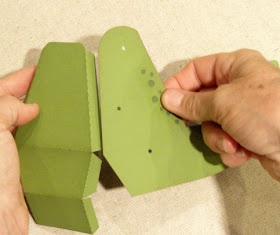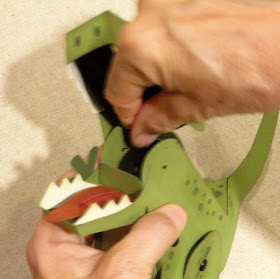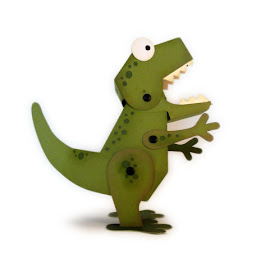Bring this "thunder lizard" to life to play along
with a child's imagination.
Measures approx. 7.5" tall x 3.5" wide (foot span)
x
7.5" front to back (jaw to tail tip)
Build body with tail box, assemble legs with platform,
upper head and jaw, then assemble with brads
(legs are glued in place for stability).
Body panels include multi-size punch holes
to simulate lizard skin, with contrast panels placed behind.
Other details include layered and slotted feet,
teeth and tongue, contrast nostrils,
layered eyes.
NOTE: This design was created following "direct inspiration"
from an image of a project originally created by Rob Ives.
This design is NOT a copy, i.e. not traced from his design,
but created and adapted to the digital cutting process.
If you are interested in purchasing and downloading
Mr. Ives' design, you can search his print designs online.
NOTE: This design was created following "direct inspiration"
from an image of a project originally created by Rob Ives.
This design is NOT a copy, i.e. not traced from his design,
but created and adapted to the digital cutting process.
If you are interested in purchasing and downloading
Mr. Ives' design, you can search his print designs online.
ASSEMBLY:
1. Identify and cut the shapes:
A body front with tummy overlay
B body sides (l & r)
C body back with tail attachment edges
D legs (l & r)
E leg brace/body support
F feet (l & r): top, middle with claws, bottom
G arms (l & r) with contrast underlay
H contrast underlays for shapes w/ spots
I head (includes top and sides)
J eye assemblies (l & r)
K upper teeth (l & r)
L nose underlay (contrast nostrils)
M jaw
N lower teeth (l & r)
O tongue and contr underlay
P tongue mid attachment stem

2. Identify the contrast underlay shapes for each of the body, head and leg shapes that have the random hole cutout pattern. Glue the contrast to the backside of the face shapes to which they correspond, taking care that the edges of the underlays do NOT overlap perforated fold lines or edges.
3. Attach the contrast arm shape behind the corresponding arm shape for both arms, lining up the brad hole punches and the edges as exactly as possible.
4. Prepare the center front body shape by folding edge tabs back, bottom section back slightly at mid horizontal lines.
5. Line up the upper section edge of body side shape with the upper front body tab, aligning the edge corner at the perforation line and glue in place.
6. Bend the body shape to align the next lower edge and corresponding tab and glue in place. Repeat for the bottom front body section that will attach along the bottom edge (partially only) of the side body.
7. Position one arm on each side of the body assembly and attach with a brad fastener through aligned punch holes.
9. Prepare the body back shape by folding the side tabs back, fold the cross perforation line back slightly.
10 Fit the body back shape between the back edges of the side body shapes, line up the corresponding straight edges and tab perforation lines and glue in place.
11. Bend the tail area perforation lines of side body shapes as necessary so that the edges line up with the tab perforation line/edge. Glue each tab to corresponding body side tab.
12. Apply glue to the backside of one of the tail extensions, then push tails together with edges aligned . . .
. . . and glue in place.
13. Bend the tummy shape slightly at mid cross perforation line. Center and attach to the body front upper and lower panels, matching perforation positions.
14. Prepare the leg shapes by folding the bottom tabs outward. Prepare the legs brace/body support by folding the side extensions inward to right angle, fold end tabs inward.
15. Identify which of the L or R legs correspond to each brace extension, then line up and attach lower brace section to corresponding portion of leg, with bottom end tabs remaining unattached.
NOTE: the area between the legs is the platform on which the body will attach.
16. Determine which is right and left foot (each flares wider to the outside; slightly narrower flare to the instep), then straighten/flatten the two leg end tabs and insert together through the top foot slot.
On the backside of the foot shape, fold the tabs away from each other to flattened positions, and glue in place.
17. Layer the middle foot (includes the claws) and the bottom foot and attach to the underside of each attached foot.
18. Position the bottom panel of the body assembly between the upper leg extensions so that it rests on the platform of the legs brace.
As indicated with pointing finger here, line up the back edges of brace and body panel, also make sure that the leg and body hole punches line up properly.
Glue body to brace.
19. Insert brad through leg and body hole and attach, for both sides of body.
20. Prepare the head section by folding panels and sections, tabs back slightly.
(All of contrast underlay panels should be in place, as shown.)
21. Form the head shape by folding to bring the first side upper edge in line with the corresponding center back edge tab perforation line. Glue edge in place to tab.
Bend to align the next side straight edge with the bottom center back section perforation line, and glue in place.
Repeat for the opposite side edges and back center section tabs.
22. Bend to align the nose tabs with the corresponding side front edges and attach.
23. Layer the eye unit by attaching the contrast (black) smallest circle behind the hole punch in the eye white circle. Attach the matched-size body colored circle behind the assembly (enclosing smallest circle).
Repeat to produce two eye units.
24. Position and attach each eye on the side of the head in the area marked by the semi-circle of perforated guide marks. Check to make sure pupils are facing forward at your selected angle, and that both eyes have this matched orientation.
25. Insert the upper teeth shapes behind the side of the head, and adjust . . .
. . . so that the front straight edge is flush next to the nose seam, back angled edge aligns at angle of the mouth/jaw curve.
Glue in place.
26. Prepare the lower jaw shape by folding sides, front and back panels and small tabs back.
27. Shape the jaw by folding the front panel upward, end tabs in, to line up the tab perforation line with the short front edge of side jaw. Glue tab in place. Repeat for opposite side of front jaw.
28. Repeat this process to attach the back panel of the jaw to side edge tabs.
29. Insert, adjust and attach the lower teeth shapes . . .
. . . so that the front end is snug against the front jaw panel, back angle is aligned at edge intersection angle.
30. Glue the tongue contrast underlay behind the cutout shape in the tongue.

31. Give the tongue assembly some curl by running it across a rod object such as this pen shaft (think curing ribbon).
Bend the end tab back at right angle.
32. Glue the back tab into place, centered, on the back panel of the jaw assembly.
33. Prepare the tongue support "stem"by folding in half, and folding each of the tiny end tabs outward.
Glue the center portion only together.
Position and attach the support in the center of the jaw under the tongue, and then . . .
glue the tongue underside to the top of it.
(This will help keep the tongue settled in the appropriate position.)
34. Position the lower jaw side extensions in place, one on each outside at the top of body, with punch holes lined up. The jaw front back panel should rest snugly against body. Glue the area immediately around the punch holes in place.
35. Position the head sides in place similarly, with each side extension over the jaw and body sides, with punch holes lined up.
Tip the head back as far as possible, and insert and secure these with a brad through each of the punch holes.
Tip the head forward into the finished position.

2. Identify the contrast underlay shapes for each of the body, head and leg shapes that have the random hole cutout pattern. Glue the contrast to the backside of the face shapes to which they correspond, taking care that the edges of the underlays do NOT overlap perforated fold lines or edges.
3. Attach the contrast arm shape behind the corresponding arm shape for both arms, lining up the brad hole punches and the edges as exactly as possible.
4. Prepare the center front body shape by folding edge tabs back, bottom section back slightly at mid horizontal lines.
5. Line up the upper section edge of body side shape with the upper front body tab, aligning the edge corner at the perforation line and glue in place.
6. Bend the body shape to align the next lower edge and corresponding tab and glue in place. Repeat for the bottom front body section that will attach along the bottom edge (partially only) of the side body.
7. Position one arm on each side of the body assembly and attach with a brad fastener through aligned punch holes.
9. Prepare the body back shape by folding the side tabs back, fold the cross perforation line back slightly.
10 Fit the body back shape between the back edges of the side body shapes, line up the corresponding straight edges and tab perforation lines and glue in place.
11. Bend the tail area perforation lines of side body shapes as necessary so that the edges line up with the tab perforation line/edge. Glue each tab to corresponding body side tab.
12. Apply glue to the backside of one of the tail extensions, then push tails together with edges aligned . . .
. . . and glue in place.
13. Bend the tummy shape slightly at mid cross perforation line. Center and attach to the body front upper and lower panels, matching perforation positions.
14. Prepare the leg shapes by folding the bottom tabs outward. Prepare the legs brace/body support by folding the side extensions inward to right angle, fold end tabs inward.
15. Identify which of the L or R legs correspond to each brace extension, then line up and attach lower brace section to corresponding portion of leg, with bottom end tabs remaining unattached.
NOTE: the area between the legs is the platform on which the body will attach.
16. Determine which is right and left foot (each flares wider to the outside; slightly narrower flare to the instep), then straighten/flatten the two leg end tabs and insert together through the top foot slot.
On the backside of the foot shape, fold the tabs away from each other to flattened positions, and glue in place.
17. Layer the middle foot (includes the claws) and the bottom foot and attach to the underside of each attached foot.
18. Position the bottom panel of the body assembly between the upper leg extensions so that it rests on the platform of the legs brace.
As indicated with pointing finger here, line up the back edges of brace and body panel, also make sure that the leg and body hole punches line up properly.
Glue body to brace.
19. Insert brad through leg and body hole and attach, for both sides of body.
20. Prepare the head section by folding panels and sections, tabs back slightly.
(All of contrast underlay panels should be in place, as shown.)
21. Form the head shape by folding to bring the first side upper edge in line with the corresponding center back edge tab perforation line. Glue edge in place to tab.
Bend to align the next side straight edge with the bottom center back section perforation line, and glue in place.
Repeat for the opposite side edges and back center section tabs.
22. Bend to align the nose tabs with the corresponding side front edges and attach.
23. Layer the eye unit by attaching the contrast (black) smallest circle behind the hole punch in the eye white circle. Attach the matched-size body colored circle behind the assembly (enclosing smallest circle).
Repeat to produce two eye units.
24. Position and attach each eye on the side of the head in the area marked by the semi-circle of perforated guide marks. Check to make sure pupils are facing forward at your selected angle, and that both eyes have this matched orientation.
25. Insert the upper teeth shapes behind the side of the head, and adjust . . .
. . . so that the front straight edge is flush next to the nose seam, back angled edge aligns at angle of the mouth/jaw curve.
Glue in place.
26. Prepare the lower jaw shape by folding sides, front and back panels and small tabs back.
27. Shape the jaw by folding the front panel upward, end tabs in, to line up the tab perforation line with the short front edge of side jaw. Glue tab in place. Repeat for opposite side of front jaw.
28. Repeat this process to attach the back panel of the jaw to side edge tabs.
29. Insert, adjust and attach the lower teeth shapes . . .
. . . so that the front end is snug against the front jaw panel, back angle is aligned at edge intersection angle.
30. Glue the tongue contrast underlay behind the cutout shape in the tongue.

31. Give the tongue assembly some curl by running it across a rod object such as this pen shaft (think curing ribbon).
Bend the end tab back at right angle.
32. Glue the back tab into place, centered, on the back panel of the jaw assembly.
33. Prepare the tongue support "stem"by folding in half, and folding each of the tiny end tabs outward.
Glue the center portion only together.
Position and attach the support in the center of the jaw under the tongue, and then . . .
glue the tongue underside to the top of it.
(This will help keep the tongue settled in the appropriate position.)
34. Position the lower jaw side extensions in place, one on each outside at the top of body, with punch holes lined up. The jaw front back panel should rest snugly against body. Glue the area immediately around the punch holes in place.
35. Position the head sides in place similarly, with each side extension over the jaw and body sides, with punch holes lined up.
Tip the head back as far as possible, and insert and secure these with a brad through each of the punch holes.
Tip the head forward into the finished position.
That completes your 3d t rex model.
He's now ready to terrorize your own Jurassic park!





































EEKK LOVE!
ReplyDeletethis is so darn awesome love it. you amaze me.
ReplyDeleteThis dino is so awesome! I love it and my boys are already drooling over it LOL!
ReplyDelete